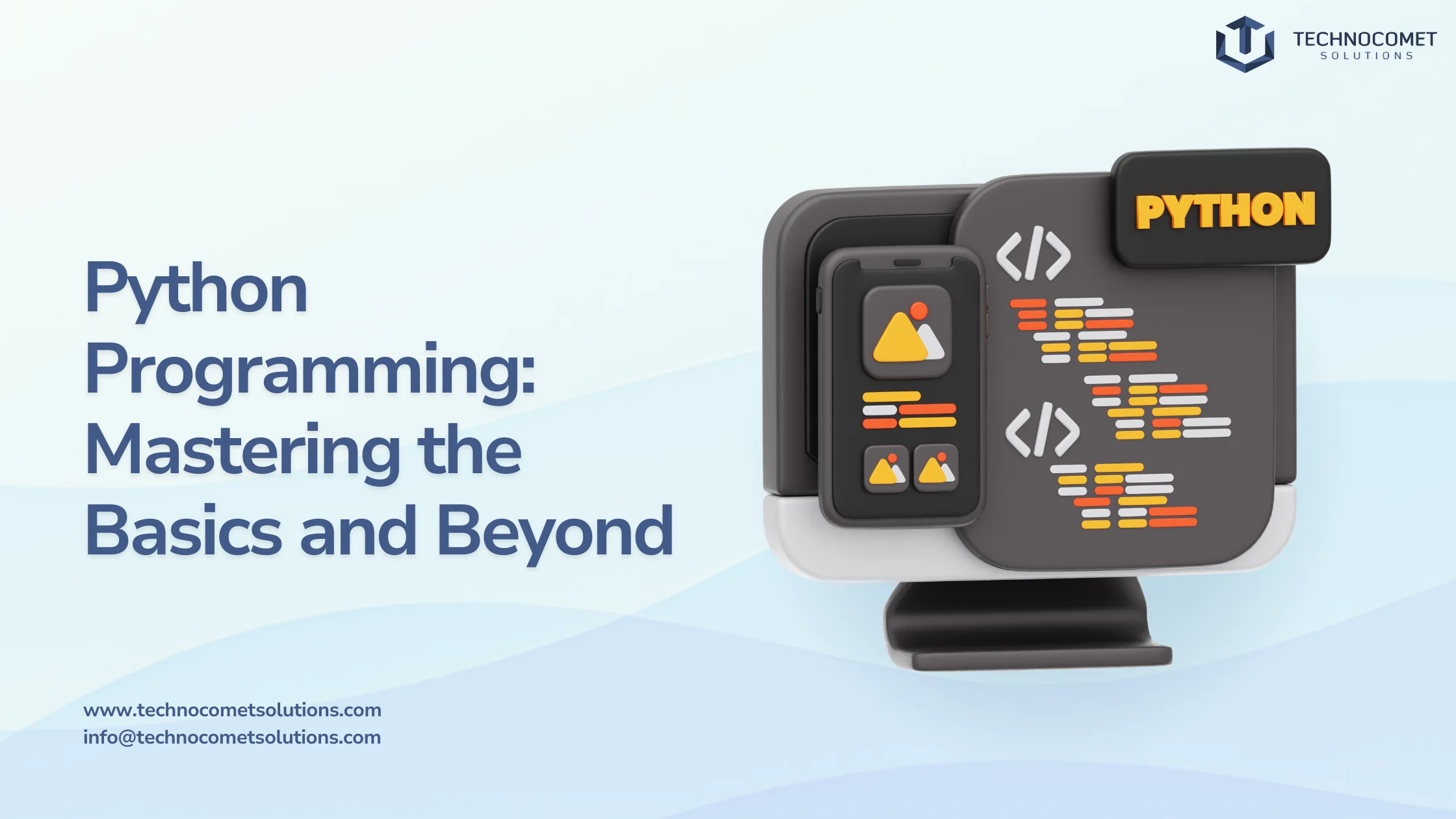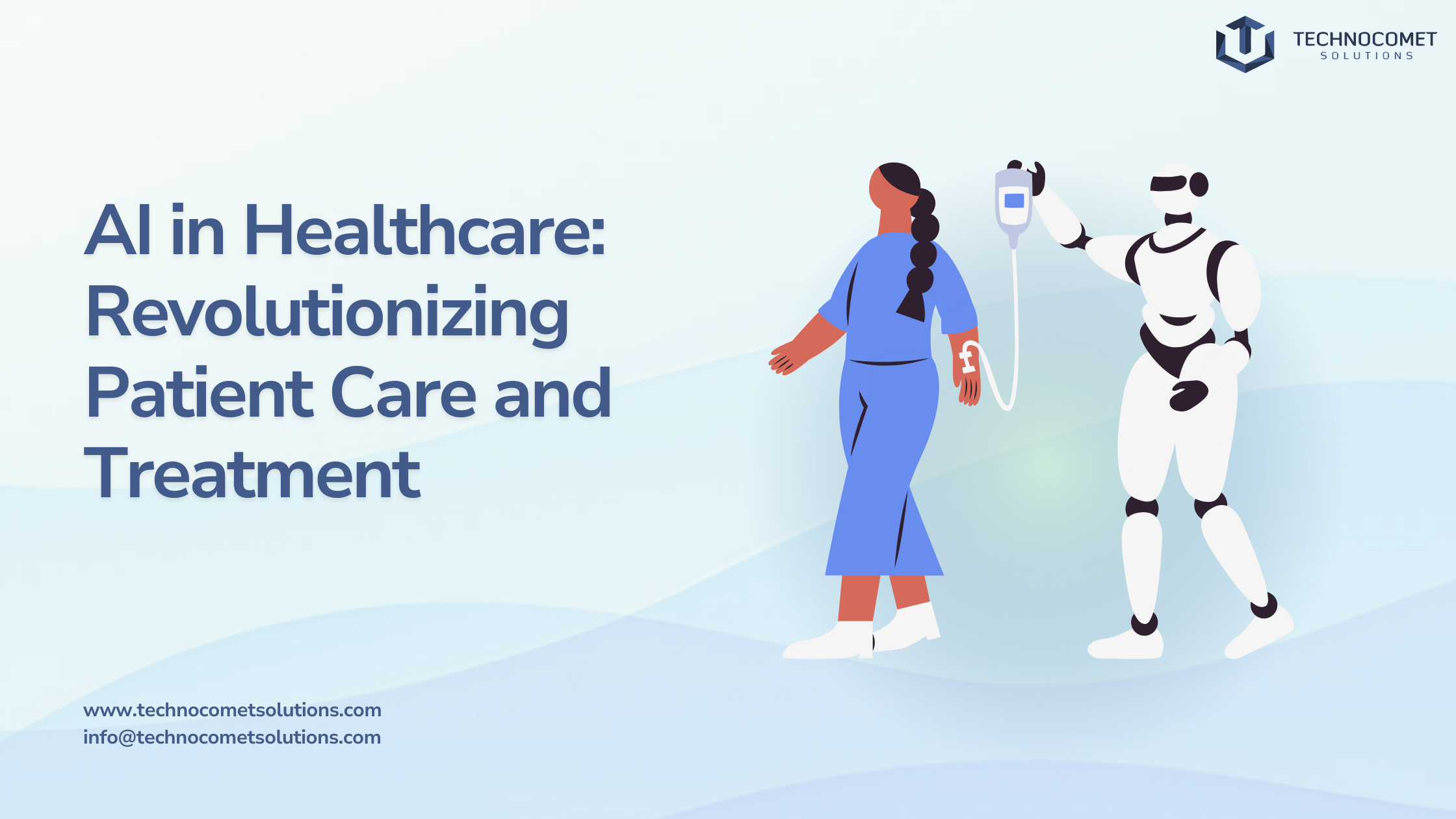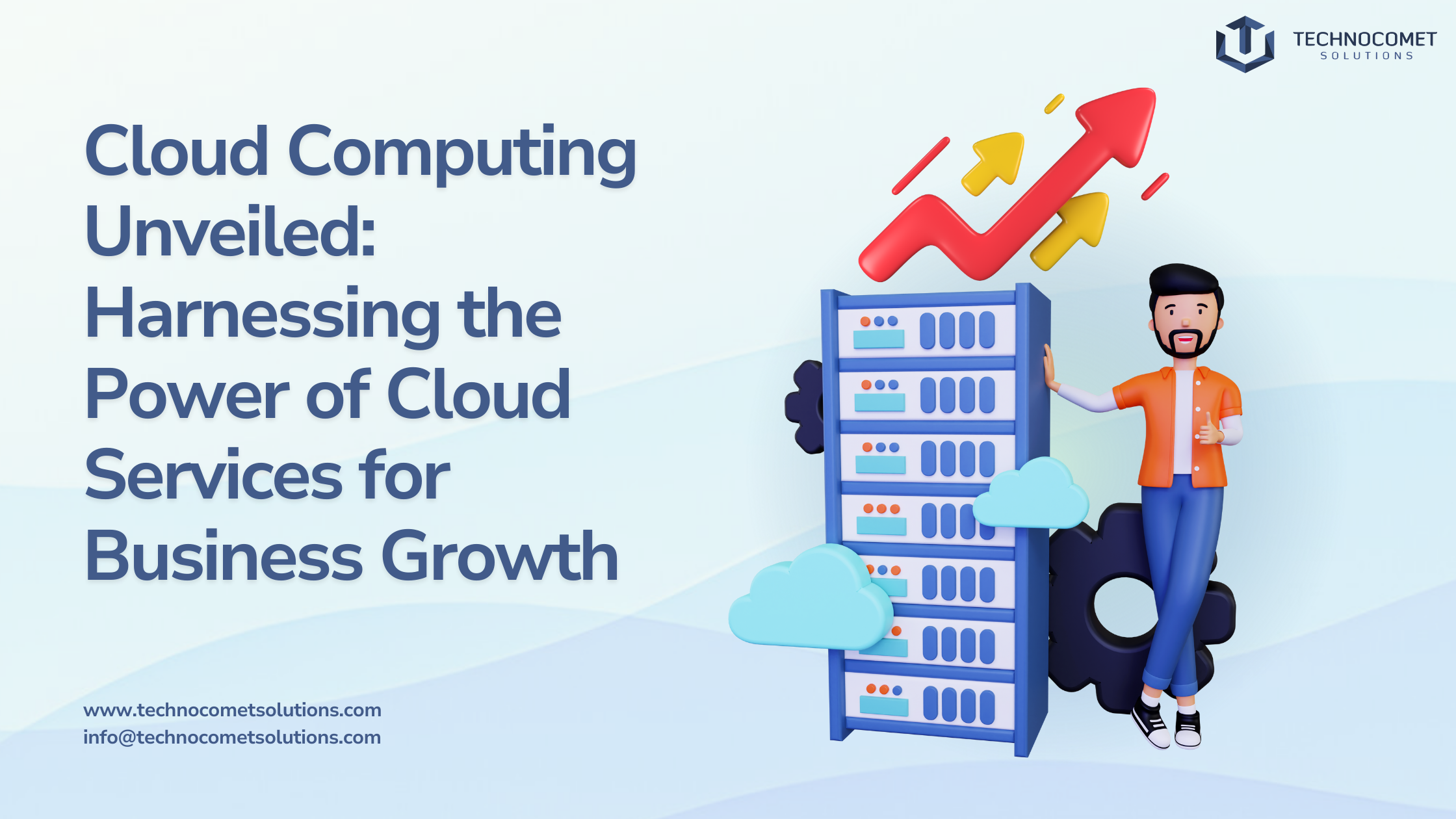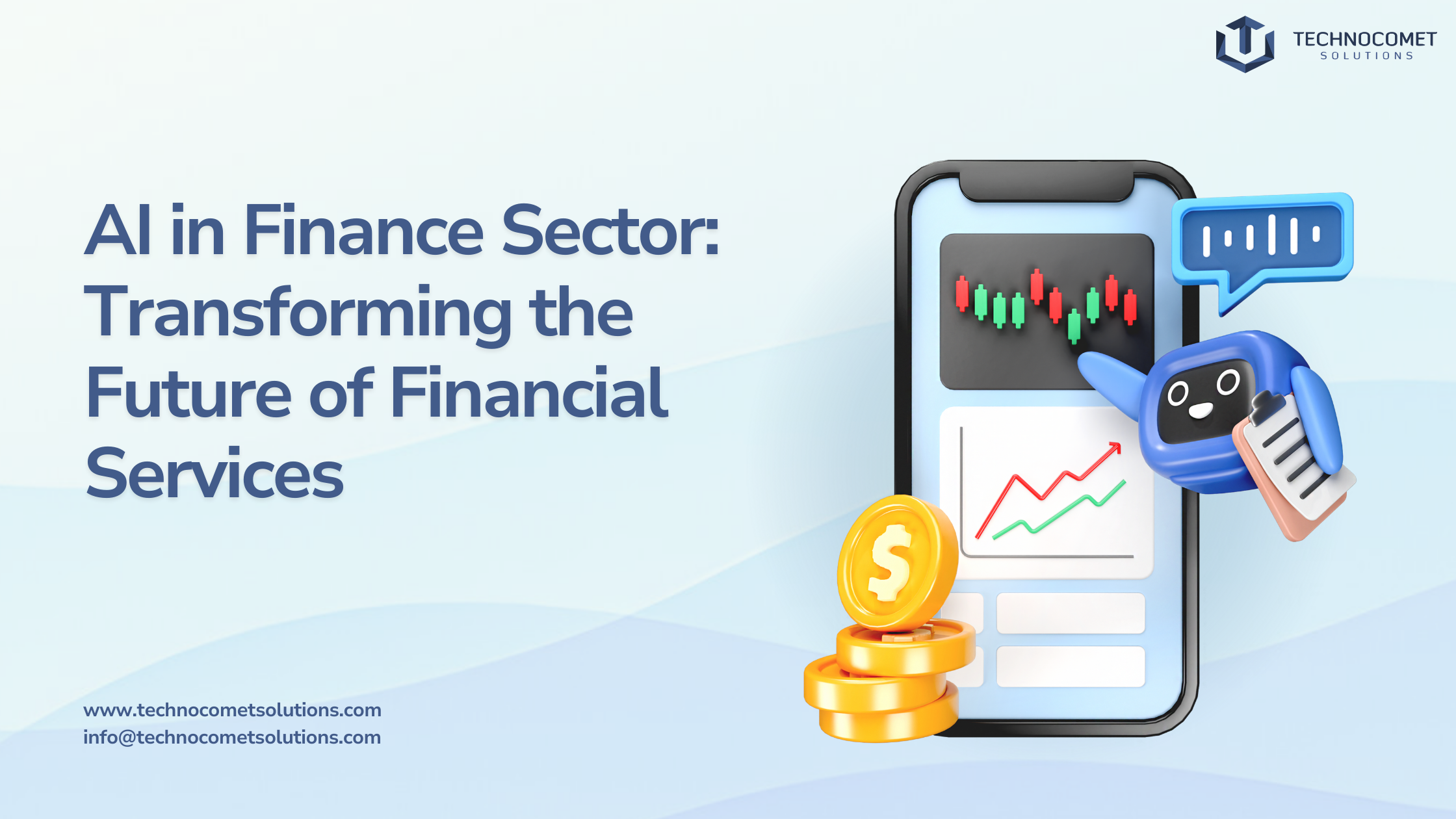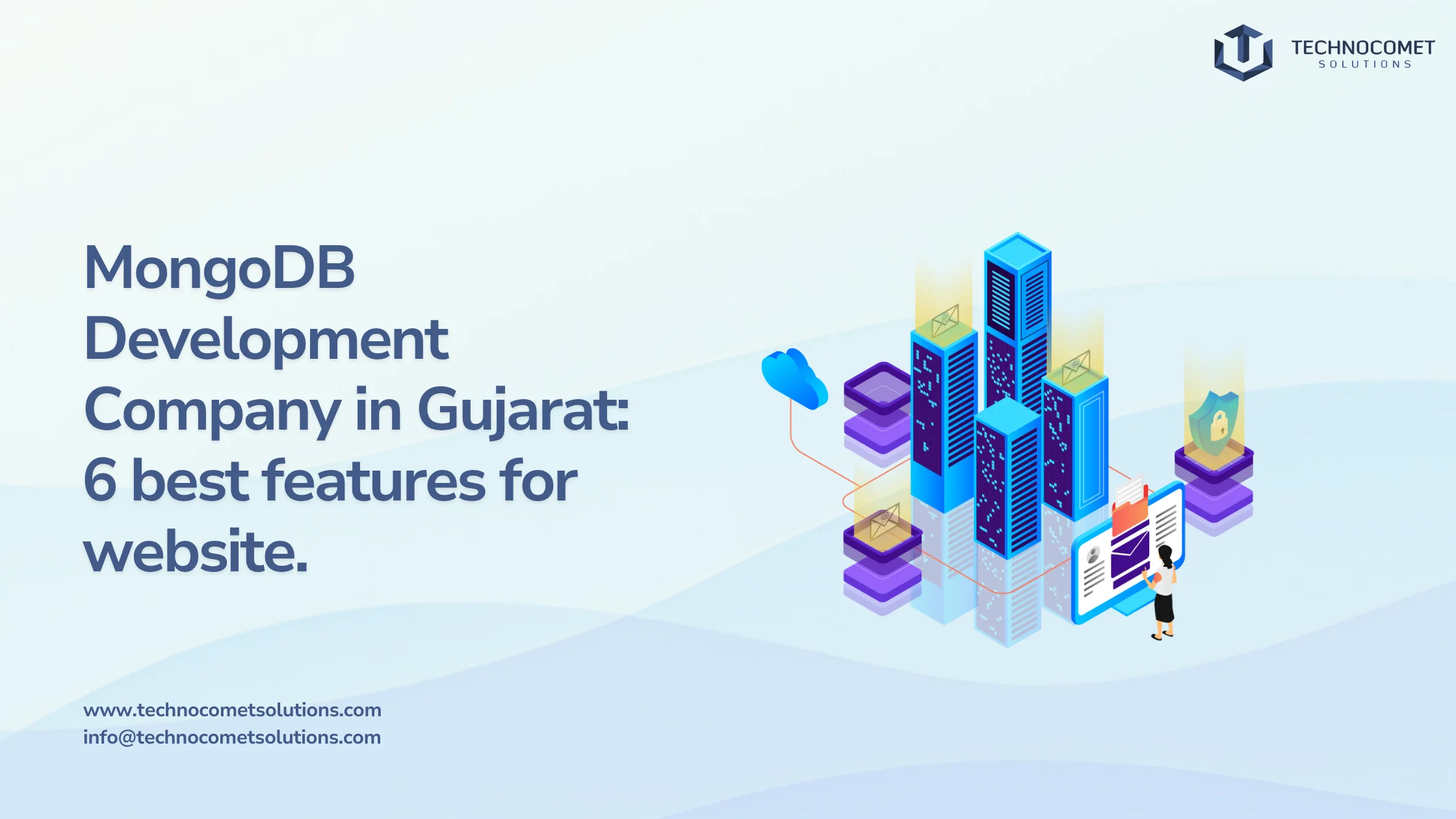Introduction
In today’s rapidly evolving technological landscape, mastering the Python programming language is more essential than ever for aspiring developers and seasoned professionals alike. Among the myriad of programming languages available, Python stands out as a must-learn language due to its simplicity, versatility, and widespread applicability across various domains. TechnoComet Solutions, a leader in innovative software solutions, recognizes the immense potential of Python programming in transforming ideas into impactful digital solutions. From web development to data science, machine learning to automation, Python programming offers a robust toolkit that empowers developers to tackle complex problems with ease. Its clean syntax and readability make it an ideal choice for beginners, while its powerful libraries and frameworks cater to advanced users looking to build sophisticated applications.
As we delve into the history of Python, explore its applications across industries, and provide practical guidance on setting up your environment and mastering the basics, you’ll discover why Python has become a cornerstone of modern software development and how it can enhance your career prospects in an increasingly digital world.
Why Python is a Must-Learn Language for Developers
Python programming has become a cornerstone in the world of software development due to its simplicity and versatility. It is a high-level language that emphasizes code readability, allowing developers to express concepts in fewer lines compared to many other languages. This characteristic makes it particularly appealing to beginners and seasoned professionals alike. The clean syntax of Python reduces the cognitive load on developers, enabling them to focus on problem-solving rather than getting bogged down by complex syntax rules.
With its extensive libraries and frameworks, Python programming is applicable in various fields, from web development to data science and machine learning. Additionally, Python’s strong community support means that there are countless tutorials, forums, and resources available for learners at all levels.
The History and Evolution of Python Programming
Python was created by Guido van Rossum in the late 1980s and was first released in 1991. The language was designed as a successor to the ABC programming language, focusing on code readability and simplicity. Over the years, Python has evolved significantly, with major versions released, including Python 2.0 in 2000 and Python 3.0 in 2008. Each version introduced new features and improvements, solidifying Python’s place as one of the most popular programming languages today.
For instance, Python 3 brought enhancements like better Unicode support and a more consistent standard library. The transition from Python 2 to Python 3 was significant; while it created some initial friction within the community due to compatibility issues, it ultimately paved the way for a more robust language that meets modern development needs.
Industries and Applications Where Python Shines
Python programming excels across various industries due to its versatility and adaptability. In web development, frameworks like Django and Flask streamline building robust web applications, offering built-in features like user authentication and database management. For data science, libraries such as Pandas and NumPy enable efficient data analysis and visualization, while tools like TensorFlow and Scikit-learn simplify the creation of machine learning models. Python also supports automation through scripts that handle repetitive tasks, increasing productivity across sectors.
Beyond these fields, Python is widely used in game development with libraries like Pygame, which simplify game creation. Its adaptability ensures relevance across evolving technologies, making it an essential tool for future-proofing careers. Python’s ability to integrate with other technologies enhances its utility, solidifying its role as a cornerstone in various domains.
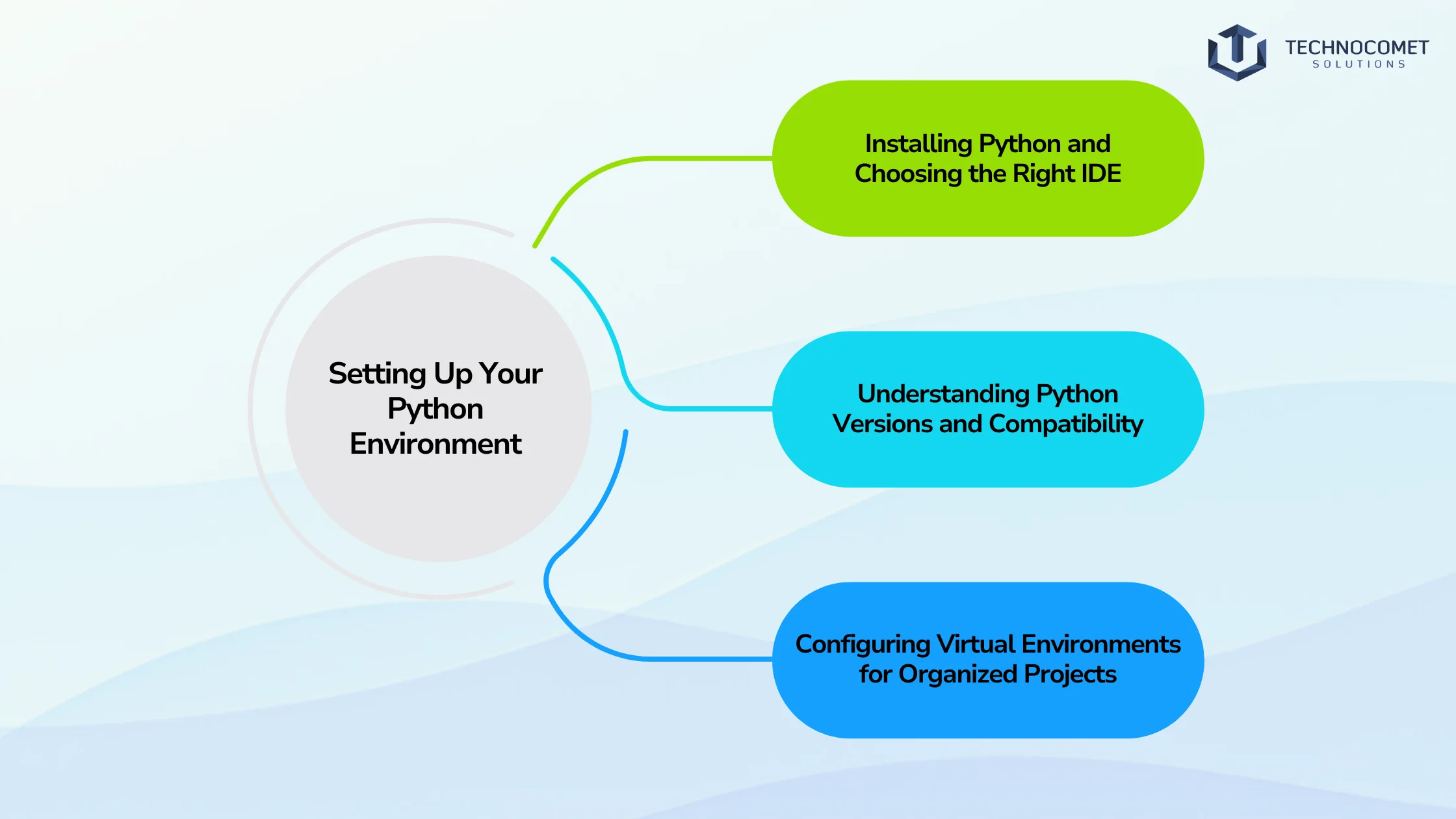
Setting Up Your Python Environment
Installing Python and Choosing the Right IDE
To start your journey with Python programming, you first need to install it on your computer. You can download the latest version from the official Python website. The installation process is straightforward; however, ensuring you select the correct options during installation, such as adding Python to your system PATH, is crucial for ease of use later on. Alongside installation, choosing an Integrated Development Environment (IDE) is crucial for writing and testing your code efficiently. Popular IDEs for Python include PyCharm (which offers powerful debugging tools), Visual Studio Code (a lightweight editor with extensive extensions), and Jupyter Notebook (ideal for data analysis and visualization).
Each IDE has its strengths; for example, Jupyter Notebook allows you to run code snippets interactively while documenting your thought process simultaneously. Additionally, many IDEs offer plugins or extensions that enhance functionality customized specifically for Python development.
Understanding Python Programming Versions and Compatibility
Python has two major versions: Python 2.x and Python 3.x. While Python 2.x was widely used for many years due to its extensive libraries and community support, it has reached its end-of-life status as of January 1, 2020. Therefore, it is recommended to focus on learning Python 3.x, which includes several improvements over its predecessor, such as enhanced syntax features like f-strings for easier string formatting. Additionally, many third-party libraries have ceased support for Python 2.x altogether; thus, learning Python 3 ensures you have access to the latest tools and community resources.
Understanding version compatibility is essential when working on projects or collaborating with others who may be using different versions of Python. Keeping your environment updated will also help you avoid potential issues related to deprecated features or libraries.
Configuring Virtual Environments for Organized Projects
Using virtual environments is a best practice in Python programming that helps manage dependencies for different projects without conflicts. Tools like venv or virtualenv allow you to create isolated environments where you can install packages specific to each project without affecting your global Python installation or other projects you may be working on simultaneously. This practice not only keeps your projects organized but also avoids version conflicts between libraries, ensuring that each project runs smoothly regardless of changes made elsewhere.
Additionally, virtual environments make it easier to share projects with others since they encapsulate all dependencies needed for that specific project setup. Learning how to effectively manage virtual environments will enhance your workflow significantly as you tackle more complex projects.
Mastering Python Basics
Understanding Syntax, Variables, and Data Types
The syntax of Python programming is straightforward and resembles natural language. Variables are dynamically typed; this means you do not need to declare their type explicitly; instead, Python determines it at runtime based on the assigned value. Common data types include integers (whole numbers), floats (decimal numbers), strings (text), lists (ordered collections), tuples (immutable ordered collections), dictionaries (key-value pairs), and sets (unordered collections of unique items). Understanding these basic data types is crucial as they form the foundation upon which more complex data structures are built.
Moreover, practicing how to manipulate these data types through various operations will deepen your understanding of their behaviors in different contexts. As you grow more comfortable with these basics, you’ll find yourself able to write more efficient code that leverages these fundamental concepts effectively.
Control Structures: Loops, Conditional Statements, and Functions
Control structures are vital for guiding a program’s flow and ensuring logical execution. Conditional statements like if, elif, and else enable decision-making by executing specific code blocks based on conditions. Loops, such as for and while, allow repetitive tasks—for loops iterate over sequences, while while loops run as long as a condition is true. Functions, created using the def keyword, promote modular programming by breaking complex tasks into reusable blocks, enhancing code clarity and reusability.
Mastering these structures enhances your ability to write efficient, dynamic programs. Additionally, understanding scope within functions prevents variable conflicts and supports cleaner code. Regular practice will sharpen your skills, helping you structure programs logically and effectively.
Core Python Programming Libraries: Simplifying Common Programming Tasks
Python’s extensive standard library simplifies programming tasks with a range of built-in modules. The math library offers mathematical functions such as trigonometry and logarithms, while datetime handles date and time operations like formatting and calculating differences. The os module facilitates file management and environment variable access, and sys provides tools for interacting with command-line arguments and managing scripts. These modules significantly reduce development time by offering ready-made solutions. By leveraging these tools, developers can focus on building robust and efficient applications.
Beyond the standard library, Python’s ecosystem includes powerful third-party libraries. Tools like Requests simplify HTTP requests, and BeautifulSoup supports web scraping tasks. These additional resources expand Python’s versatility, enabling developers to tackle advanced challenges efficiently.
Diving Into Advanced Python Programming Concepts
Object-Oriented Programming: Classes, Objects, and Inheritance
Object-oriented programming (OOP) in Python is a paradigm that structures code using “objects,” effectively modeling real-world entities. At the core of OOP are classes, which serve as blueprints for creating objects. Classes encapsulate data attributes (properties) and methods (functions) that define the behavior of the objects. Objects are specific instances of classes, each with unique attribute values but shared methods. A key feature of OOP is inheritance, where a child class inherits properties and methods from a parent class, promoting code reuse. This structure simplifies complex applications by organizing data and behavior logically. Beyond inheritance, OOP principles like polymorphism enhance flexibility and scalability.
Polymorphism allows child classes to redefine methods of the parent class, ensuring consistent interfaces across diverse objects. By mastering these concepts, developers can design extensible systems that align closely with real-world scenarios, improving maintainability and adaptability.
Working with Modules, Packages, and Python Programming Standard Library
Modules are files containing reusable pieces of code that can be imported into other programs using the import statement, allowing developers to break down their codebase into manageable sections while promoting reuse across projects. Packages are collections of modules organized in directories. They help structure large applications effectively by grouping related modules together under a single namespace. The standard library provides numerous modules covering everything from file I/O operations (os, shutil) to internet protocols (http, ftplib).
Familiarizing yourself with these modules will enhance your productivity by allowing you to leverage existing solutions rather than reinventing the wheel each time you start a new project!
Error Handling and Debugging Techniques for Efficient Coding
Error handling is crucial for creating robust applications, as unexpected issues like invalid user input or network failures can disrupt functionality. Python programming provides tools such as the try block, which encapsulates code that may raise exceptions, and the except block, which catches and handles specific errors gracefully to prevent program crashes. The finally block executes regardless of exceptions, making it ideal for cleanup tasks like closing files or releasing resources. Proper use of these tools ensures smoother program execution and enhances reliability.
Debugging techniques, such as strategically placed print statements or leveraging debugging tools in IDEs, help identify and resolve issues quickly during development. By combining effective error handling with proactive debugging, developers can save time and build resilient applications that handle unforeseen scenarios seamlessly.
Real-World Applications of Python Programming
Building Web Applications with Frameworks like Django and Flask
Python programming is widely used in web development through frameworks like Django (for large-scale applications), which follows a “batteries-included” philosophy, providing built-in features such as user authentication systems out of the box, and Flask (for lightweight applications), which offers flexibility through minimalistic design principles, allowing developers greater control over components used within their applications. These frameworks streamline common web development tasks such as routing requests to users’ browsers and managing databases through Object Relational Mapping (ORM), making it easier than ever before for developers to use new web technologies!
Furthermore both frameworks have rich ecosystems supporting plugins and extensions, enabling rapid prototyping and production-ready solutions seamlessly!
Leveraging Python Programming for Data Science and Machine Learning
In the realm of data science, a field focused on extracting insights from vast amounts of information, libraries such as Pandas facilitate data manipulation tasks, including cleaning datasets, while NumPy provides powerful numerical computing capabilities essential for performing mathematical operations on large arrays and matrices efficiently!
Moreover, advanced machine learning frameworks like TensorFlow allow practitioners not only to build neural networks but also to deploy them seamlessly across different platforms, from mobile devices all the way up to cloud servers! This versatility makes Python programming an indispensable tool for analysts seeking to derive actionable insights from their datasets quickly!
Automation and Scripting for Everyday Productivity
Python programming can automate mundane tasks, file management, or web scraping using libraries like BeautifulSoup and Scrapy, enabling users to streamline workflows dramatically! For example, imagine being able to pull information off websites automatically rather than manually every time. Moreover, automating repetitive tasks saves significant time allowing individuals to focus on more strategic initiatives rather than getting bogged down in tedious chores!
Whether it’s sending emails at scheduled intervals or generating reports automatically, you’ll find countless opportunities to leverage Python programming to enhance productivity both personally and professionally! Embracing automation not only boosts efficiency but also fosters creativity by freeing up mental bandwidth to explore innovative solutions to challenges faced daily!
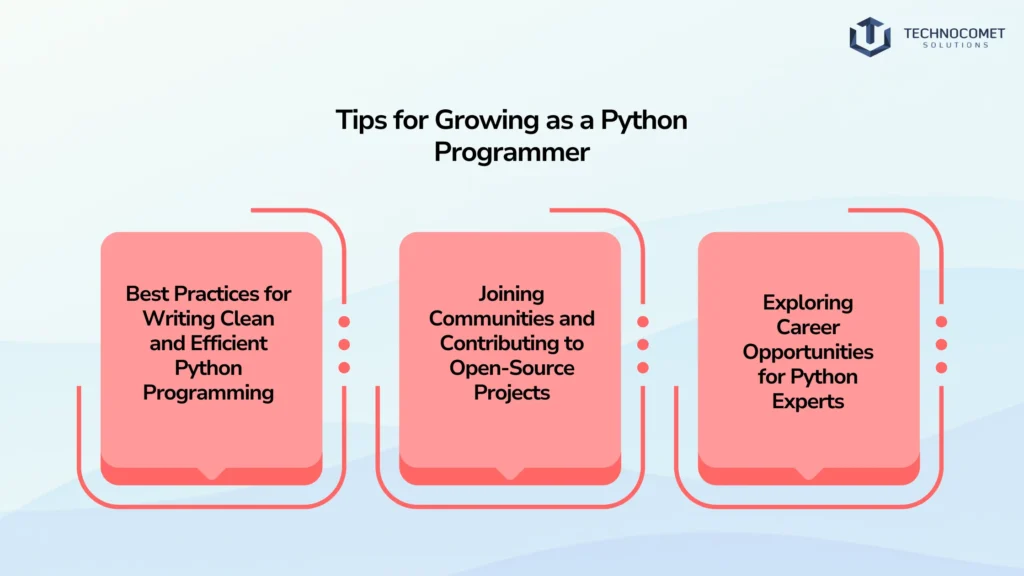
Tips for Growing as a Python Programmer
Best Practices for Writing Clean and Efficient Python Programming
To write effective code, follow PEP 8 guidelines for consistency in style, ensuring better readability and easier maintenance. This standard makes it simpler to update code in the future and helps developers quickly understand each other’s work. Use descriptive variable names that clarify their purpose without relying on excessive comments. Write comments to explain complex logic, but avoid unnecessary explanations to keep the code clean. Strive for a balance between clarity and brevity in your comments. This approach promotes a more readable and efficient codebase.
Additionally, leverage linters and formatters to automatically enforce coding standards, reducing time spent on manual checks. Peer reviews encourage collaboration and the sharing of best practices, benefiting the entire team and improving overall code quality.
Joining Communities and Contributing to Open-Source Projects
Engaging communities like Stack Overflow and GitHub can enhance the learning experience through other developers who share similar interests and passions! Participating in discussions, asking questions, seeking feedback, and finding invaluable resources are all ways to grow! Contributing to open-source projects exposes real-world coding practices while building showcasing skills to potential employers! Many organizations actively seek contributors and maintainers for their projects, fostering a collaborative spirit, innovation, and growth!
Networking through conferences and meetups provides opportunities to connect with industry leaders and learn about emerging trends shaping the future landscape of the job market!
Exploring Career Opportunities for Python Experts
As demand grows, professionals skilled in Python programming across industries such as finance, healthcare, technology, etc., have numerous career opportunities awaiting those proficient in this language! Roles range from software data analyst to machine learning engineer, all requiring varying levels of expertise in Python programming proficiency! Networking, attending conferences, and workshops are also great ways to connect with industry leaders and learn about emerging trends and technologies shaping the landscape of the job market!
Exploring specialized courses further enhances credibility and skillset, increasing attractiveness to prospective employers seeking talent to navigate the evolving tech landscape successfully!
Future Trends in Python Programming
The Role of Python Programming in Emerging Technologies like AI and IoT
Python continues to play a crucial role in emerging technologies such as artificial intelligence (AI) and the Internet of Things (IoT), where versatility allows developers to create innovative solutions rapidly! With the rise of smart devices, interconnected systems need robust languages to handle complexity as it seamlessly grows exponentially! Moreover, libraries dedicated specifically to AI applications, such as TensorFlow and PyTorch, offer powerful tools for researchers and practitioners alike to build and deploy cutting-edge models efficiently!
As businesses increasingly adopt AI-driven strategies, understanding how to leverage Python programming effectively becomes essential for ensuring successful implementation of transformative initiatives and future-proofing organizations against disruption in the competitive landscape!
How Python Programming Continues to Adapt to Modern Development Needs
The language evolves through regular updates introducing new features while maintaining backward compatibility where possible, ensuring existing applications remain functional even after upgrades! Recent enhancements include async capabilities enabling concurrent execution tasks, improving overall performance scalability, especially web services handling high volumes of traffic! Additionally, community-driven initiatives ensure Python programming stays relevant, addressing feedback from developers around the globe and fostering a collaborative spirit of innovation and growth!
Embracing agile methodologies encourages iterative improvements and responsiveness to changing requirements, ultimately benefiting users and stakeholders alike and enhancing the overall satisfaction experience!
Predictions for Python’s Place in the Programming World
Given current trajectory popularity among developers, especially in fields like data science, Python programming is expected to remain the leading choice well into the future! Its emphasis on simplicity and readability, combined with a vast ecosystem of libraries, positions it to meet the demands of the modern software development landscape! As industries increasingly rely on automation analytics skills, proficiency in Python programming will undoubtedly become an essential asset for the workforce paving the way for exciting opportunities for those willing to embrace the journey ahead!
Continuous investment in personal development and staying abreast of emerging trends and technologies is vital to sustaining a competitive edge in the evolving job market driven by rapid advancements and innovation, transforming traditional paradigms on a daily basis!
Conclusion
In conclusion, mastering Python programming opens doors to countless opportunities across various domains due to its versatility, ease of use, and strong community support! Whether you’re interested in web development, data science, or anything in between, learning provides valuable skills highly sought after in today’s job market! By embracing this powerful language, now position yourself at the forefront of technological advancement while enjoying a fulfilling journey in world coding! Every expert was once a beginner; take small steps, practice diligently, and soon enough you’ll find yourself navigating complexities effortlessly, unlocking the full potential Python offers! Celebrate each milestone along the way; recognizing progress made fuels continued striving for excellence and growing continuously throughout the career path ahead, filled with endless possibilities awaiting discovery. Exploration and adventure await those who dare to venture forth boldly and
If you’re eager to dive deeper into the world of Python programming and elevate your skills further, consider partnering with TechnoComet Solutions. We offer comprehensive IT customized to help you master Python and leverage its capabilities in your projects. Contact us today!
FAQs
Python programming is a high-level, interpreted programming language known for its easy-to-read syntax and versatility. It supports multiple programming paradigms, including object-oriented, procedural, and functional programming, making it suitable for a wide range of applications from web development to data analysis.
Key features of Python programming include its simplicity and readability, extensive standard library, dynamic typing, and support for integration with other languages. It also offers powerful frameworks and libraries for various tasks, such as Django for web development and Pandas for data manipulation.
To install Python programming, visit the official Python website, download the installer for your operating system (Windows, macOS, or Linux), and follow the installation instructions. Make sure to check the option to add Python to your system PATH during installation for easier access.
Python programming can be used for a variety of tasks, including web development, data analysis, artificial intelligence, machine learning, automation of tasks, and scripting. Its flexibility allows developers to create everything from simple scripts to complex applications across different domains.

